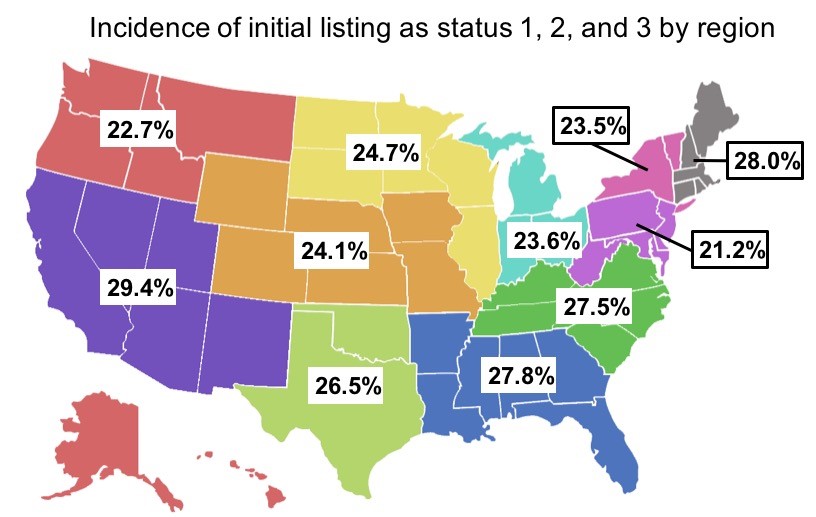Distribution of High-Urgency Listing and Regional Variation before and after Implementation of the 2018 US Heart Allocation Policy
1University of Michigan, Ann Arbor, MI, 2SRTR, Minneapolis, MN
Meeting: 2020 American Transplant Congress
Abstract number: 294
Keywords: Adverse effects, Heart transplant patients, Survival, Waiting lists
Session Information
Session Name: Heart Transplantation: Allocation, Allocation, Allocation
Session Type: Oral Abstract Session
Date: Saturday, May 30, 2020
Session Time: 3:15pm-4:45pm
 Presentation Time: 3:39pm-3:51pm
Presentation Time: 3:39pm-3:51pm
Location: Virtual
*Purpose: The demand for heart transplant exceeds organ availability. The Organ Procurement and Transplantation Network/United Network for Organ Sharing (OPTN/UNOS) updated heart allocation policy in October 2018. The goal of the new policy is to provide equitable access to heart failure patients in need of this limited, life-saving resource. The policy increased the number of statuses from three (1A, 1B, 2) to six, splitting the previous status 1A into status 1, 2, and 3, and implemented broader geographic sharing for status 1 and 2. Regional variation in how statuses are used may result in inequitable organ sharing among regions.
*Methods: We used SRTR data to determine the distribution of urgency status among new adult listings before and after new heart policy was implemented, November 2017-July 2018 and November 2018-July 2019. Distributions of high-urgency listings were compared before (status 1A) and after (statuses 1, 2, and 3) implementation. Frequency of listing by status among the 11 UNOS regions was compared.
*Results: In the period prior to the new policy, 5667 candidates were actively listed, and 5566 after implementation. Prior to the new policy, 1162 candidates (20.5%) were listed as status 1A. After implementation, 745 (13.4%) were listed as status 1 or 2, and 1432 (25.7%) as status 1, 2, or 3. There was considerable variation in status at the time of initial listing by region (p<0.0001). Prior to the new policy, high-urgency (status 1A) listings varied from 10.6% to 25.6%. After implementation, status 1 listings varied from 0.75% to 5.0%, status 2 from 6.1% to 14.5%, and status 3 from 6.0% to 17.6%. The figure shows proportions of candidates listed as status 1, 2, or 3 by region.
*Conclusions: High-urgency listings increased with implementation of the new heart allocation policy, and listings in the highest-urgency categories (status 1 and 2) comprise 13.4% of all listings. Despite more specific listing criteria under the new policy, substantial regional variation in transplant listing status remains. Program and regional variations in strategies at the time of listing can potentially result in inequitable access to donor hearts.
To cite this abstract in AMA style:
Cascino T, Skeans M, Patel V, Colvin M. Distribution of High-Urgency Listing and Regional Variation before and after Implementation of the 2018 US Heart Allocation Policy [abstract]. Am J Transplant. 2020; 20 (suppl 3). https://atcmeetingabstracts.com/abstract/distribution-of-high-urgency-listing-and-regional-variation-before-and-after-implementation-of-the-2018-us-heart-allocation-policy/. Accessed December 23, 2025.« Back to 2020 American Transplant Congress

